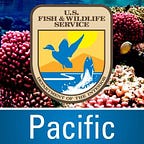An Unexpected Visit: Commercial Airline Safely Diverted to Midway Atoll
Midway Atoll National Wildlife Refuge and Battle of Midway National Memorial is a refuge for millions of seabirds and a living memorial of the courage and sacrifice of those who fought in Battle of Midway in WWII. Part of Papahānaumokuākea Marine National Monument, it is also home to Henderson Field (Midway Atoll), operated by FWS, in conjunction with the Federal Aviation Administration, as an ETOPS (Extended-Range Twin-Engine Operations Standards) runway providing a diversion runway for north-Pacific trans-continental flights.
On September 24, a Hawaiian Airlines flight with 67 passengers and 12 crew enroute from Incheon International Airport to Honolulu Daniel K. Inouye International Airport, landed at Midway Atoll at approximately 8:43 a.m. (HST). The flight’s captain received a low oil pressure notification and, out of an abundance of caution, elected to divert the Airbus A330 aircraft to Midway Atoll. The plane landed safely and no injuries were reported.
U.S. Fish and Wildlife Service staff and volunteers and government contractors, Defense Base Services, Inc. employees, provided assistance to the passengers and crew.
Once the plane landed and was safely parked on the runway, the passengers were provided shaded shelter and places to sit, food — including a hot lunch, and water. The passengers and crew are able to walk around and Midway Atoll staff set up a soccer net for the kids on the plane to use. The passengers and crew also had the air-conditioned plane available as a place to rest if they did not feel like stretching their legs or being outside in the shaded tents.
“The U.S. Fish and Wildlife Service staff, volunteers, and contractors were glad to be able render aid and provide support to the passengers and crew of Hawaiian Airlines flight 460,” said Amanda Boyd, Deputy Superintendent, Papahānaumokuākea Marine National Monument. “Our primary concerns were making sure folks were safe and cared for during their time at Midway Atoll.”
A replacement aircraft was dispatched to Midway Atoll from Honolulu with a team of mechanics and crew members. It picked up the passengers and returned them safely to Honolulu late in the evening, around 9:00 p.m. (HST). The mechanics and crew members remain on Midway Atoll to inspect the original aircraft and will ferry it back to Honolulu.
Henderson Field (Midway Atoll) has been used for aircraft safety diversions a number of times in the past 15 years, including commercial passenger airliners, cargo flights, and U.S. military flights.
“The FAA is an essential partner at Midway Atoll and Henderson Field, which provides critical safety support for flights crossing the Pacific,” said Boyd. “We are glad that the passengers from today’s flight have been returned safely to Honolulu. We will continue to provide support to the onsite mechanics and crew until they are able to return to Honolulu.”
Midway Atoll (Kuaihelani) lies approximately halfway between the continental western U.S. and Asia, and is approximately 1,200 miles NW of Honolulu, Hawaii, in the Pacific Ocean. Extremely remote and difficult to reach, there are not a lot of modern facilities to accommodate visitors, as it is typically closed to visitors. There are only 57 staff and volunteers that currently live and work there.
While on Midway Atoll, the passengers and crew on the emergency runway were surrounded by seabirds on one of the most important seabird colonies in world and memorials to the courage and sacrifice to those who fought in the Battle of Midway — which took place from June 4–7, 1942. It was one of the most decisive battles of World War II and proved to be the turning point of the War in the Pacific.
Nearly three million birds nest at the Refuge and Memorial each year, including the world’s largest population of moli (albatrosses), nunulu (Bonin petrels), and endangered koloa maoli (Laysan ducks). It is also one of only two places in the world where the highly endangered short-tailed albatross breeds. One of the world’s most endangered marine mammals, `ilio holo i ka uaua (Hawaiian monk seal), as well as the endangered honu (green sea turtle) and nai’a (spinner dolphins), frequent Midway’s coral-ringed, crystal blue lagoon. The atoll is a biologically rich, historically significant, culturally sacred and an uniquely diverse spot on the globe.
As a national wildlife refuge, a national memorial, and part of a marine national monument, Midway Atoll has a unique set of protections and opportunities. The Service, together with Monument co-managers at NOAA, the State of Hawai’i, the Office of Hawaiian Affairs and a diverse representation of engaged partners work to protect and promote the natural and cultural history at Midway Atoll (Kuaihelani) and throughout the Northwestern Hawaiian Islands of Papahānaumokuākea Marine National Monument.
Though Midway Atoll is far in the Central Pacific Ocean, you can visit and take a a virtual tour by clicking here. During the tour, you can learn more about the Battle of Midway, the amazing wildlife, and the islands that make up the atoll. Below, you will find a video that talks about Battle of Midway and the Midway Atoll’s transition from a U.S. military airfield to the a sanctuary for wildlife and history.
The U.S. Fish and Wildlife Service works with others to conserve, protect, and enhance fish, wildlife, plants, and their habitats for the continuing benefit of the American people. For more information, connect with us through any of these social media channels at https://www.facebook.com/PacificIslandsFWS, www.flickr.com/photos/usfwspacific/, or www.twitter.com/USFWSPacific.
